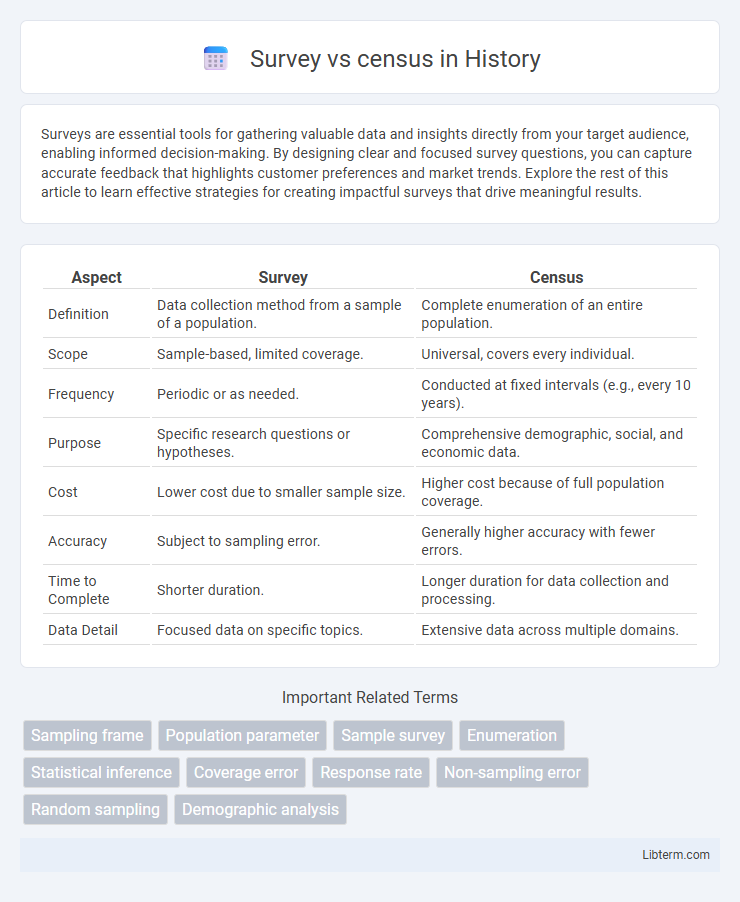Surveys are essential tools for gathering valuable data and insights directly from your target audience, enabling informed decision-making. By designing clear and focused survey questions, you can capture accurate feedback that highlights customer preferences and market trends. Explore the rest of this article to learn effective strategies for creating impactful surveys that drive meaningful results.
Table of Comparison
| Aspect | Survey | Census |
|---|---|---|
| Definition | Data collection method from a sample of a population. | Complete enumeration of an entire population. |
| Scope | Sample-based, limited coverage. | Universal, covers every individual. |
| Frequency | Periodic or as needed. | Conducted at fixed intervals (e.g., every 10 years). |
| Purpose | Specific research questions or hypotheses. | Comprehensive demographic, social, and economic data. |
| Cost | Lower cost due to smaller sample size. | Higher cost because of full population coverage. |
| Accuracy | Subject to sampling error. | Generally higher accuracy with fewer errors. |
| Time to Complete | Shorter duration. | Longer duration for data collection and processing. |
| Data Detail | Focused data on specific topics. | Extensive data across multiple domains. |
Introduction to Surveys and Censuses
Surveys collect data from a representative sample of a population, enabling efficient analysis of trends and behaviors without examining every individual. Censuses involve gathering information from the entire population, providing comprehensive and detailed demographic data at a specific point in time. Both methods play crucial roles in data collection, with surveys offering cost-effective insights and censuses delivering complete population coverage for policy and planning purposes.
Defining a Survey
A survey involves collecting data from a subset of a population to infer characteristics about the entire group, aiming to minimize cost and time while maintaining accuracy. Unlike a census, which gathers information from every member of a population, a survey uses sampling techniques such as random or stratified sampling to ensure representativeness. Surveys provide flexibility in data collection methods, including questionnaires, interviews, and online forms, making them essential for analyzing trends and opinions efficiently.
Defining a Census
A census is a comprehensive data collection process that aims to gather information from every individual or unit within an entire population. It provides detailed and accurate demographic, economic, and social data, enabling governments and researchers to make informed decisions and policy planning. Unlike surveys, a census covers all members of the target population, offering a complete statistical snapshot at a specific point in time.
Key Differences Between Survey and Census
A census collects comprehensive data from every member of a population, ensuring complete accuracy but requiring significant time and resources. Surveys gather information from a representative sample, enabling quicker, cost-effective analysis while sacrificing some precision. The choice between survey and census depends on the need for detail, budget constraints, and the desired frequency of data collection.
Advantages of Conducting a Survey
Surveys offer cost-effective data collection by targeting representative samples rather than entire populations, making them ideal for budget-conscious research. They provide flexibility in question design and quicker turnaround times, allowing for timely decision-making and adjustments. Surveys also minimize respondent burden and increase data accuracy through focused, manageable respondent groups.
Advantages of Conducting a Census
Conducting a census provides comprehensive and accurate data by collecting information from the entire population, ensuring no segment is overlooked. This exhaustive approach enables detailed demographic, social, and economic analysis at granular geographic levels, supporting precise policy-making and resource allocation. Unlike surveys, censuses eliminate sampling errors and provide a complete dataset essential for national planning and development strategies.
Limitations of Surveys
Surveys often face limitations such as sampling bias, which can skew results if the sample is not representative of the entire population. They also rely on self-reported data, leading to potential inaccuracies due to misreporting or misunderstanding of questions. Unlike a census, which covers the entire population, surveys cannot capture every individual's perspective, creating gaps in comprehensive data analysis.
Limitations of Censuses
Censuses face significant limitations including high cost, extensive time requirements, and logistical challenges, especially in large or hard-to-reach populations. Data accuracy can be compromised due to undercounting, nonresponse, and reporting errors, impacting the reliability of census results. Unlike surveys that allow sampling and more frequent updates, censuses are conducted infrequently, limiting their ability to reflect rapid demographic changes.
When to Use a Survey vs. Census
Use a census when gathering comprehensive data from an entire population is essential, such as in national population counts or detailed demographic studies. Surveys are more practical for collecting information from a sample subset, especially when time, budget, or resources limit the feasibility of a full census. Choosing between a survey and a census depends on the research goals, required data accuracy, and available logistical capabilities.
Conclusion: Choosing the Right Data Collection Method
Selecting between survey and census depends on the research objectives, budget, and required accuracy. Surveys offer cost-effective, timely data collection from a representative sample, ideal for large populations. Censuses provide comprehensive, detailed data without sampling error, essential for complete population insights despite higher costs and longer processing times.
Survey Infographic

 libterm.com
libterm.com